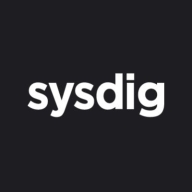

Sysdig Secure and XM Cyber compete in the cybersecurity solutions category. While Sysdig Secure has its strengths, XM Cyber generally offers superior features, making it the preferred choice for those who prioritize comprehensive capabilities.
Features: Sysdig Secure provides cloud security features, real-time threat detection, and performance monitoring. XM Cyber offers attack simulation, automated security assessments, and comprehensive risk analysis. XM Cyber’s features are more robust and encompassing, making it preferable for comprehensive security needs.
Room for Improvement: Sysdig Secure could improve its integrations, scalability, and user management. XM Cyber could benefit from enhanced performance monitoring, easier setup processes, and better dashboard customizations.
Ease of Deployment and Customer Service: Sysdig Secure offers a straightforward deployment process but has slow support response times. XM Cyber is easier to deploy and has responsive and helpful customer service, delivering a smoother deployment experience.
Pricing and ROI: Sysdig Secure is cost-effective but has mixed ROI according to user reviews. XM Cyber has higher costs but offers better ROI with its advanced features. Users believe XM Cyber’s higher cost is justified by its enhanced functionalities and return on investment.


In the cloud, every second counts. Attacks move at warp speed, and security teams must protect the business without slowing it down. Sysdig stops cloud attacks in real time, instantly detecting changes in risk with runtime insights, a unique AI architecture, and open source Falco. Sysdig delivers live visibility by correlating signals across cloud workloads, identities, and services to uncover hidden attack paths. By knowing what is running, teams can prioritize the vulnerabilities, misconfigurations, permissions, and threats that matter most. From prevention to defense, Sysdig helps enterprises move faster and focus on what matters: innovation.
Sysdig. Secure Every Second.
XM Cyber is a leading hybrid cloud security company that’s changing the way innovative organizations approach cyber risk. Our attack path management platform continuously uncovers hidden attack paths to your critical assets across cloud and on-prem environments, so you can cut them off at key junctures and eradicate risk with a fraction of the effort. This overcomes the big disconnect that security teams experience when they’re presented with endless alerts, yet can’t see which exposures impact risk the most, how they come together to be exploited by an attacker, or how to efficiently eliminate them. This approach is a complete game-changer, which is why some of the world’s largest, most complex organizations choose XM Cyber to help eradicate risk. Founded by top executives from the Israeli cyber intelligence community, XM Cyber has offices in North America, Europe, and Israel.
We monitor all Cloud Security Posture Management (CSPM) reviews to prevent fraudulent reviews and keep review quality high. We do not post reviews by company employees or direct competitors. We validate each review for authenticity via cross-reference with LinkedIn, and personal follow-up with the reviewer when necessary.